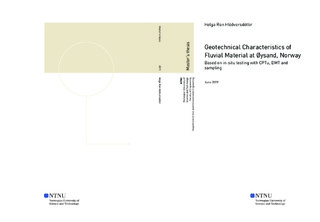| dc.description.abstract | Obtaining high quality, representative samples of granular soil (gravel, sand and silt) is a challenge in geotechnical practice. Instead, field investigation tests have become more effective to gain useful geotechnical information about the sub-soil. The most popular penetration test nowadays is the Cone Penetration Test with pore pressure measurements (CPTu). One of the most valuable information obtained from the CPTu is the determination of the sub-surface stratigraphy and identification of the present materials. Over the years, various empirical charts which correlate the CPTu parameters to soil classification have been developed, as well as a soil behaviour index which numerically classifies the soil. The aim of this project is to test these charts for the soil at Øysand and find the most efficient and reliable way for classification of the soil using results of CPTu. Also, to present engineering parameters describing the soil. Øysand is a natural sand site used in this project, located in Melhus municipality central Norway. The site is a part of a much larger project called the Norwegian Geo-Tests Sites (NGTS) and is one of five test sites located in Norway. To back up the results of the CPTu, they are compared to samples taken at Øysand and also results from seismic Dilatometer tests. The disadvantage of these penetration tests is that they do not work well in coarse soils, as the penetration can damage the equipment. The results divide the fluvial material in the top ten meters of the stratigraphy in three groups. The first layer (I) of clean sands from 1.8-3.5 m depth, the second layer (II) which lies on the boarder of gravelly sands and clean sands from 3.5-5 m depth and the third layer (III) of clean sands to sand mixtures, silty sand to sandy silt, from 5 - 10m depth. However, it seems that the fine content within the soil has big impact on the soil behaviour under penetration. Meaning that the coarse layers seen in samples are not recognized using the popular soil behaviour charts presented by \cite{Robertson90} and \cite{Robertson16}. Therefore it is recommended, for the Øysans sand site, to use a classification chart based on shear wave velocity measurements, as it fully recognize the coarseness of the soil. However, if shear wave velocity data is not available it is recommended to use the soil behaviour index for soil classification. For the Øysand site it is recommended to shift the boundary between the gravelly sand and clean sand (zones (7) and (6) according to the Robertson 1990 chart) from 1.31 to 1.61 to account for the gravelly material. | |
